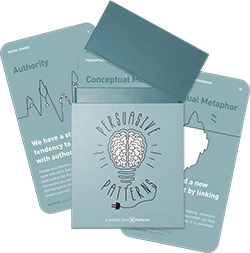Trigger
Design Pattern
Alternate titles: Prompt, Cue, Call to action, Request.
Problem summary
Place cues on our regular paths to remind and motivate us to take action
Usage
- Use to remind or motivate users to take action
This card is part of the Persuasive Patterns printed card deck
The Persuasive Patterns Card Deck is a collection of 60 design patterns driven by psychology, presented in a manner easily referenced and used as a brainstorming tool.
Get your deck!Solution
- Spark motivation. In situations where users have the ability, but lack the motivation, increasing motivation is your go-to strategy. Highlighting fear, inspiring hope, or inducing a sense of belonging are well-tested strategies to spark motivation.
- Make hard things easier. In situations where users have a high motivation, but lack ability, facilitating behavior is your weapon of choice. Where training people is hard, costly, and takes time, simplifying tasks is a more effective strategy in leveling required ability with actual ability. A third option is to scale back the ambitions of a target behavior to something smaller. Starting small, first, will provide momentum for something bigger, later.
- Provide a signal. In situations where users have both high motivation and high ability to perform a target behavior, a signal, for instance a simple reminder, is enough. A signal could be a traffic light, request, call to action, a cue, email, tweet, or other distraction.
Rationale
Without an appropriate prompt, behavior will not occur – even if we are both motivatated and able. Timing is key. When we are ready to perform a behavior, a well-timed trigger is a welcome distraction. A trigger is successfull when we notice it (so we can act on it), when we associate it with the target behavior, and when it comes at a time where we are both motivated and able to perform the behavior. Triggers can be external (an alarm sounding) or in form of an internal cue (walking through the kitchen triggers opening the fridge).
Triggers cue the user to take action in the context they are in. Triggers might be notifications, tweets, emails, text messages, links, or other distractions. Offline triggers should also be considered. Triggers can be set (alarms), brought home (printed reminder sheet), or follow an action (ask someone a question).
Having established the Captology Lab at Stanford (renamed to Behavior Design Lab), BJ Fogg was among the first to research persuasive technologies. His Fogg Behavior Model has become a foundational pillar of persuasive design. It states that three elements must converge at the same moment for a behavior to occur: Motivation, Ability, and a Prompt (called Trigger in the first edition of the model). B = MAP.
1 Fogg Behavior Model & Prompts at behaviormodel.org
2 Fogg, BJ (2009). A behavior model for persuasive design, Persuasive ’09: Proceedings of the 4th International Conference on Persuasive Technology. Pages 1–7
User Interface Design Patterns
- Forms
- Explaining the process
- Community driven
- Tabs
- Jumping in hierarchy
- Menus
- Content
- Gestures
- Tables
- Formatting data
- Images
- Search
- Reputation
- Social interactions
- Shopping
- Increasing frequency
- Guidance
- Registration
Persuasive Design Patterns
- Loss Aversion
- Other cognitive biases
- Scarcity
- Gameplay design
- Fundamentals of rewards
- Gameplay rewards


